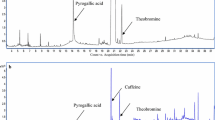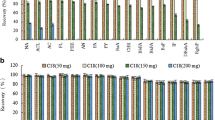Abstract
A modified Luke rapid detection method followed by gas chromatography–mass spectrometry (GC–MS) has been developed for the simultaneous determination of 42 pesticides in ginseng tea. This method uses acetone and n-hexane solution to extract and partition pesticides. Ginseng tea samples were mixed with acetone, water and n-hexane solution, and then partitioned by vortex. After the partition, the top layer (n-hexane) was transferred into a centrifuge tube containing primary secondary amine (PSA), graphitized carbon black (GCB) and C18 for purification. And then the centrifuge supernatant was injected into GC–MS. The Luke method was applied in ginseng tea sample detection, and we confirmed that this method can easily extract various types of pesticides from ginseng tea samples. The rates of recovery for pesticides studied were satisfactory, ranging from 65.5 to 109.0 % with a relative standard deviation (RSD) of less than 12 %. The limits of quantification (LOQs) ranged between 0.5 and 11.5 μg·kg−1. The modified Luke method is quick and easy.




Similar content being viewed by others
References
Acosta-Tejada GM, Medina-Peralta S, Moguel-Ordóñez YB, MuñozRodríguez D (2011) Matrix solid-phase dispersion extraction of organophosphorus pesticides from propolis extracts and recovery evaluation by GC/MS. Anal Bioanal Chem 400:885–891
Andrey S, Igor R, Arkady B, Oleg SB (2013) The use of linear ion trap for qualitative analysis of phytochemicals in Korean ginseng tea. Biomed Chromatogr 27:765–774
Chen HP, Yin P, Wang QH, Jiang Y, Liu X (2014) A modified QuEChERS sample preparation method for the analysis of 70 pesticide residues in tea using gas chromatography-tandem mass spectrometry. Food Anal Methods 7:1577–1587. doi:10.1007/s12161-014-9791-0
Duda RB, Taback B, Kessel B, Dooley DD, Yang H, Marchiori J, Slomovic BM, Alvarez JG (1996) PS2 expression induced by American ginseng in MCF-7 breast cancer cells. Ann Surg Oncol 3:515–520
Gamon M, Lleo C, Ten A, Mocholi F (2001) Multiresidue determination of pesticides in fruit and vegetables by gas chromatography–tandem mass spectrometry. J AOAC Int 84(4):1209–1216
Hajslova J, Holadova K, Kocourek V (1998) Matrix-induced effects: a critical point in the gas chromatographic analysis of pesticide residues. J Chromatogr A 800:283–295
Hiemstra M, Kok AD (2007) Comprehensive multi-residue method for the target analysis of pesticides in crops using liquid chromatography–tandem mass spectrometry. J Chromatogr A 1154:5–21
Khan IA, Allgood J, Walker LA, Abourashed EA, Schlenk D, Benson WH (2001) Determination of heavy metals and pesticides in ginseng products. J AOAC Int 84(3):936–939
Kim HK, Lee KS (2002) Effect of coverings on the growth of ginseng and the persistency of procymidone in growing soils. Korea J Environ Agra 21(1):24–30
Kim YJ, Jeon JN, Jang MG, Oh JY, Kwon WS, Jung SK, Yang DC (2014) Ginsenoside profiles and related gene expression during foliation in Panax ginseng Meyer. J Ginseng Res 38:66–72
Lam S, Ng T (2001) Isolation of a small chitinase-like antifungal protein from Panax notoginseng (sanchi ginseng) roots. Int J Biochem Cell B 33:287–292
Lehotay SJ, Mastovska K, Lightfield AR, Gates RA (2010) Multi-analyst, multi-matrix performance of the QuEChERS approach for pesticide residues in foods and feeds using HPLC/MS/MS analysis with different calibration techniques. J AOAC Int 93:355–367
Li Z, Guo YY, Wu CF, Li X, Wang JH (1999) Protective effects of pseudoginsenoside-F11 on scopolamine-induced memory impairment in mice and rats. J Pharm Pharmacol 51:435–440
Lu DS, Qiu XL, Feng C, Jin YE, Lin YJ, Xiong LB, Wen YM, Wang DL, Wang GQ (2012) Simultaneous determination of 45 pesticides in fruit and vegetable using an improved QuEChERS method and online gel permeation chromatography–gas chromatography/mass spectrometer. J Chromatogr B 2012(895–896):17–24
Luke MA, Froberg JE, Masumoto HT (1975) Extraction and cleanup of organochlorine, organophosphate, organonitrogen, and hydrocarbon pesticides in produce for determination by gas-liquid chromatography. J Assoc Off Anal Chem 58:1020–1026
Luke MA, Froberg JE, Doose GM, Matsumoto HT (1981) Improved multiresidue gas chromatographic determination of organophosphorus, organonitrogen, and organohalogen pesticides in produce, using flame photometric and electrolytic conductivity detectors. J Assoc Off Anal Chem 64:1187–1195
Luo D, Fang B (2008) Structural identification of ginseng polysaccharides and testing of their antioxidant activities. Carbohyd Polym 72:376–381
Magdalena SB (2015) Validation of a QuEChERS-based gas chromatographic method for multiresidue pesticide analysis in fresh peppermint including studies of matrix effects. Food Anal Methods 8:1413–1424
Mahady GB, Gyllenhaal C, Fong HHS, Farnsworth NR (2000) Ginseng: a review of safety and efficacy. Nutr Clin Care 3:90–101
Payá P, Anastassiades M, Mack D, Sigalova I, Tasdelen B, Oliva J, Barba A (2007) Analysis of pesticide residues using the quick easy cheap effective rugged and safe (QuEChERS) pesticide multiresidue method in combination with gas and liquid chromatography and tandem mass spectrometric detection. Anal Bioanal Chem 389:1697–1714
Pihlström T, Blomkvist G, Friman P, Pagard U, Osterdahl BG (2007) Analysis of pesticide residues in fruit and vegetables with ethyl acetate extraction using gas and liquid chromatography with tandem mass spectrometric detection. Anal Bioanal Chem 389:1773–1789
Psoma AK, Pasias IN, Bletsou AA, Thomaidis NS (2015) Development and validation of a multi-residue method for the determination of pesticides in Chios mastic gum by QuEChERS and liquid chromatography–tandem mass spectrometry. Food Anal Methods 8:624–634
Pyzunska K (2011) Carbon nanotubes as sorbents in the analysis of pesticides. Chemosphere 83:1407–1413
Qiu YQ, Lu X, Pang T, Ma CF, Li X, Xu GW (2008) Determination of radix ginseng volatile oils at different ages by comprehensive two-dimensional gas chromatography/time-of-flight mass spectrometry. J Sep Sci 31:3451–3457
Ravelo-Pérez LM, Hernandez-Borges J, Rodriguez-Delgado MA (2008) Multiwalled carbon nanotubes as efficient solid-phase extraction materials of organophosphorous pesticides from apple, grape, orange and pineapple fruit juices. J Chromatogr A 1211:33–42
Saieva C, Aprea C, Tumino R, Masala G, Salvini S, Frasca G (2004) Twenty-four-hour urinary excretion of ten pesticide metabolites in healthy adults in two different areas of Italy (Florence and Ragusa). Sci Total Environ 332:71–80
Shi Y, Sun CJ, Zheng B, Gao B, Sun AM (2013) Simultaneous determination of ten ginsenosides in American ginseng functional foods and ginseng raw plant materials by liquid chromatography tandem mass spectrometry. Food Anal Methods 6:112–122
Shim JH, Abd El-Aty AM, Choi JH, Choi YS (2007) Post-harvest HPLC determination of chlorfluazuron residues in pears treated with different programs. Biomed Chromatogr 21:695–700
Steinwandter H (1990) Contributions to the on-line method for the extraction and isolation of pesticide residues and environmental chemicals II. Miniaturization of the on-line method Fresenius Zeitschrift Analytical Chemistry 336:8–11
Steinwandter H (1992) Development of Microextraction methods in residue analysis. In: Cairns T, Sherma J (eds) Emerging strategies for pesticide analysis. CRC, Boca Raton, FL, 3:50 [OpenURL]
Vuksan V, Sievenpiper JL, Koo VYY, Francis T, BeljanZdravkovic U, Xu Z, Vidgen E (2001) American ginseng (Panax quinquefolius L.) reduces postprandial glycemia in nondiabetic subjects and subjects with type 2 diabetes mellitus. Arch Intern Med 160:1009–1013
Walorczyk S, Gnusowski B (2009) Development and validation of a multi-residue method for the determination of pesticides in honeybees using acetonitrile-based extraction and gas chromatography–tandem quadrupole mass spectrometry. J Chromatogr A 1216:6522–6531
Wan JY, Fan Y, Yu QT, Ge YZH, Yan CP, Raphael N, Ping L, Ma ZHH, Qi LW (2015) Integrated evaluation of malonyl ginsenosides, amino acids and polysaccharides in fresh and processed ginseng. J Pharm Biomed 107:89–97
Wong JW, Webster MG, Halverson CA, Hengel MJ, Ngim KK, Ebeler SE (2003) Multiresidue pesticide analysis in wines by solid-phase extraction and capillary gas chromatography-mass spectrometric detection with selective ion monitoring. J Agric Food Chem 51:1148–1461
Xiang Y, Wang H, Zhang H, Xu PP, Qi XF, Ji Q, Wang XQ (2013) Direct chiral determination of acephate and its metabolite methamidophos in vegetables using QuEChERS by gas chromatography–tandem mass spectrometry. Food Anal Methods 6:133–140
Zhang Y, Xu H (2014) Determination of triazoles in tea samples using dispersive solid phase extraction combined with dispersive liquid–liquid microextraction followed by liquid chromatography-tandem mass spectrometry. Food Anal Methods 7:189–196
Zhang JM, Wu YL, Lu YB (2013) Simultaneous determination of carbamate insecticides and mycotoxins in cereals by reversed phase liquid chromatography tandem mass spectrometry using a quick, easy, cheap, effective, rugged and safe extraction procedure. J Chromatogr B 915–916:13–20
Zhao HX, Zhao SC, Deng LG, Mao JS, Guo CY, Yang GS, Lu X, AboulEnein HY (2013) Rapid determination of organonitrogen, organophosphorus and carbamate pesticides in tea by ultrahighperformance liquid chromatography-tandem mass spectrometry (UPLC-MS/MS). Food Anal Methods 6(2):497–505
Author information
Authors and Affiliations
Corresponding authors
Ethics declarations
The manuscript has not been submitted to more than one journal for simultaneous consideration.
The manuscript has not been published previously (partly or in full), unless the new work concerns an expansion of previous work (please provide transparency on the reuse of material to avoid the hint of text recycling).
Consent to submit has been received explicitly from all co-authors, as well as from the responsible authorities—tacitly or explicitly—at the institute/organization where the work has been carried out, before the work is submitted.
Authors whose names appear on the submission have contributed sufficiently to the scientific work and therefore share collective responsibility and accountability for the results.
Funding
This study was funded by 2011-Z55 Analysis and Safety Warning System Form of common pesticide residue levels on ginseng in Jilin province.
Conflict of Interest
Xuanwei Xu declares that he has no conflict of interest. Shuang Liang declares that she has no conflict of interest. Yueru Li declares that she has no conflict of interest. Zhongbin Lu declares that he has no conflict of interest.
Ethical Approval
This article does not contain any studies with human participants or animals performed by any of the authors.
Informed Consent
Informed consent was obtained from all individual participants included in the study.
Additional information
Xuanwei Xu and Shuang Liang contributed equally to this work.
Rights and permissions
About this article
Cite this article
Xu, X., Liang, S., Li, Y. et al. Pesticide Residue Rapid Extraction from Ginseng Tea Using a Modified Luke Method for GC–MS. Food Anal. Methods 9, 2231–2240 (2016). https://doi.org/10.1007/s12161-016-0400-2
Received:
Accepted:
Published:
Issue Date:
DOI: https://doi.org/10.1007/s12161-016-0400-2




